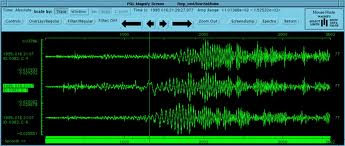A wastewater disposal well in the Youngstown area of northeast Ohio almost certainly caused 11 minor earthquakes since last spring, a seismologist investigating the quakes said on January 2nd.
Research is continuing on the now-shut injection well at Youngstown and seismic activity, but it might take a year for the wastewater-related rumblings in the earth to dissipate, said John Armbruster of Columbia University’s Lamont-Doherty Earth Observatory in Palisades, N.Y. Injection wells have also been suspected in quakes in Astabula in far northeast Ohio, and in Arkansas, Colorado, and Oklahoma, Armbruster said.
The earthquake on Saturday at 4.0 magnitude involves a fault line where enough pressure created seismic activity. Armbruster said Monday he expects more quakes will occur despite the shutdown of the Youngstown well. “The earthquakes will trickle on as a kind of a cascading process once you’ve caused them to occur,” he said. “This one year of pumping is a pulse that has been pushed into the ground, and it’s going to be spreading out for at least a year.”
The Ohio Governor said 177 deep injection wells have operated without incident in Ohio for decades and the Youngstown well was closed within 24 hours of a study detailing how close this recent quake was to the well. The industry-supported Ohio Oil and Gas Association said the rash of quakes was “a rare and isolated event that should not cast doubt about the effectiveness” of injection wells. Such wells “have been used safely and reliably as a disposal method for wastewater from oil and gas operations in the U.S. since the 1930s,” the association’s executive vice president, Thomas E. Stewart, said in a statement Monday.
Permits allowing hydraulic fracturing in Ohio’s portion of the Marcellus shale and the deeper Utica Shale formations rose from one in 2006 to at least 32 in 2011.


{ 4 comments… read them below or add one }
As the vice-president of Ohio Oil and Gas Association said, such wells may “have been used safely and reliably as a disposal method for wastewater from oil and gas operations in the U.S. since the 1930s,” but as is the case with recent horizontal drilling and the amounts of water and pressure needed to frack the wells and the amount of waste water to be dealt with — not to mention the size and impacts from todays mammoth coal mines (mountaintop removal type strip mines and large longwall underground mine operations) — it’s all a matter of scale…….
And the scale of these operations has overwhelmed the controls and regulations currently in place to maintain them as safe and environmentally sound projects. … They may not all fail, but enough ‘accidents’ and disruptive events have happened coincidental to these operations that continuing to drill full speed ahead is hardly a wise course to follow.
Thank you all for adding your thoughtful commentaries to the news of these important happenings.
There are 80 documented fatalities from windmill power generation:
http://www.caithnesswindfarms.co.uk/accidents.pdf
Some solar power devices are killing people:
http://www.scientificamerican.com/article.cfm?id=explosive-gas-silane-used-to-make-photovoltaics
Why aren’t the advocates of a moratorium on “fracking” also calling for a moratorium on solar and wind power generation?
I believe that a reasoned examination of the damages already done to the land, roads, water systems and air quality in West Virginia by Marcellus drilling and fracking provides ample justification for a moratorium. The State of New York readily recognized this. The people living in the Delaware valley recognize this to be true. Ohio is substantially divided over this question. It has noting to do with wind mills or solar power. If such drilling and fracking are justified, it should only be done under the strictest regulations and controls. D.G.N.
Wind power generator installation would do similar damage to roads, since they require heavy construction equipment. More damage would be done to the land, since wind generation requires much more acreage than drilling pads. Then add the overhead power lines collecting the electricity to the damage assessment.
While drilling does have its costs, mostly temporary during the drilling process, fracking per se has not been particularly troublesome, although environmental radicals have managed to make it much more important in the public mind than the evidence justifies. That will change as the truth comes out.